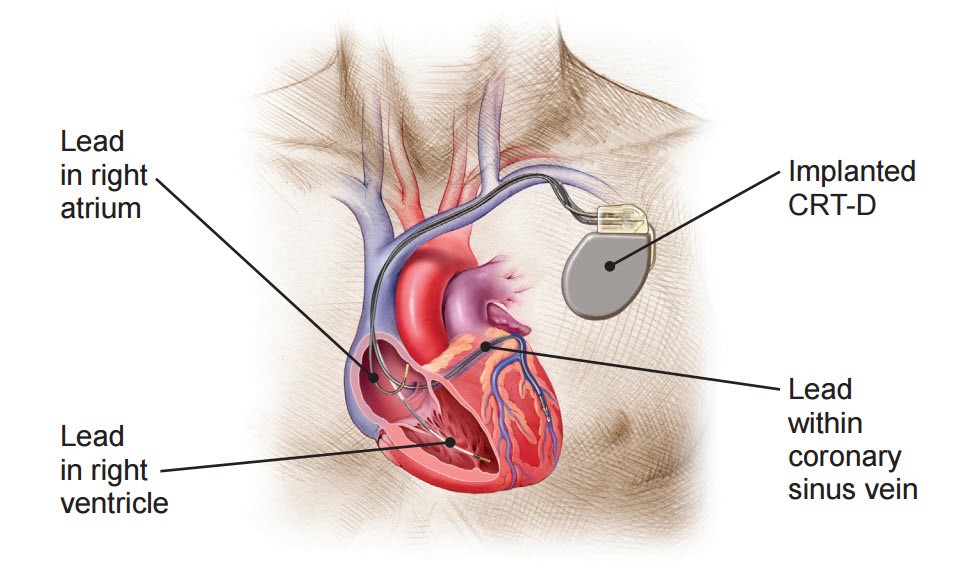Cardiac Resynchronization Therapy Cost In India
Cardiac resynchronization therapy (CRT-D Implantation) cost in India starts from 7000 to 25000 USD depends on quality of Implant. surgeons experience and Hospital services.
The required hospital stay is of 2-3 days and 5 days outside the hospital.
The success rate of Cardiac resynchronization therapy is more than 96%. In severe cases, some risks may arise such as infection at the blooding and abnormal heart rhythms.
Electrocardiogram, Echocardiogram, X-ray and Angiography may be performed to identify heart problems.

Overview
Cardiac resynchronization therapy is a procedure to implant a device in your chest to make your heart’s chambers squeeze (contract) in a more organized and efficient way.
Cardiac resynchronization therapy (CRT) uses a device called a biventricular pacemaker (also called a cardiac resynchronization device) that sends electrical signals to both lower chambers of your heart (ventricles). The signals trigger your ventricles to contract in a more coordinated way, which improves the pumping of blood out of your heart.
Sometimes the device also contains an implantable cardioverter-defibrillator (ICD), which can deliver an electrical shock to reset your heartbeat if your heart rhythm becomes dangerously erratic.
Why it's done
Cardiac resynchronization therapy is a treatment for heart failure in people whose ventricles don’t contract in a coordinated fashion.
If you have heart failure, your heart muscle is weakened and may not be able to pump out enough blood to support your body. This can be worsened if your heart’s chambers aren’t in sync with each other.
Cardiac resynchronization therapy may reduce your symptoms of heart failure and lower your risk of heart failure complications, including death.
Types of CRTs
There are two types of CRT devices. One is a special kind of pacemaker. It’s called a cardiac resynchronization therapy pacemaker (CRT-P) or “biventricular pacemaker.” The other is the same device, but it also includes a built-in implantable cardioverter defibrillator (ICD). This type is called a cardiac resynchronization therapy defibrillator (CRT-D).
How CRT-P Devices Work
While functioning like a normal pacemaker to treat slow heart rhythms, a CRT-P device also delivers small electrical impulses to the left and right ventricles to help them contract at the same time so you heart pumps more efficiently.

How CRT-D Devices Work
A CRT-D is a special device for heart failure patients who are also at high risk for sudden cardiac death. While functioning like a normal pacemaker to treat slow heart rhythms, a CRT-D device also delivers small electrical impulses to the left and right ventricles to help them contract at the same time. This will help your heart pump more efficiently.
A CRT-D device can also treat dangerously fast heart rhythms (arrhythmias) that can lead to sudden cardiac arrest. If the device senses heartbeats that are dangerously fast, it delivers a shock to the heart. This shock (defibrillation) stops the abnormal rhythm. Without this life-saving therapy, the dangerously rapid rhythm could lead to death in just minutes.

Your CRT Device Battery
CRM patients are generally told to expect that the battery life of their device is about five years for CRT-D devices and as many as seven or eight for ICDs. Devices with additional features such as continuous pacing, remote monitoring and anti-tachycardia pacing therapy during charging can exhaust batteries more quickly.
Since the battery is permanently sealed inside your device, it can’t be replaced when its energy is depleted. So if your battery runs out, your entire device will need to be replaced. The battery life depends on the settings your doctor programs and how much therapy you receive.
Your CRT device will regularly check its own battery and your doctor will check to see how much energy it has left at each follow-up visit. In addition, your doctor can turn on a feature that makes your device beep when replacement time is near. Call to Medicare Spots immediately if your device beeps.
CRT-P and CRT-D Implant Risks
While complications don’t happen very often, it’s important to know that there are risks associated with the implantation of any device or lead. You should talk with your doctor about these risks, including the ones below.
Some of the risks encountered during the implant procedure include, but are not limited to, the following:
- Bleeding
- Formation of a blood clot
- Damage to adjacent structures (tendons, muscles, nerves)
- Puncture of a lung or vein
- Damage to the heart (perforation or tissue damage)
- Dangerous arrhythmias
- Heart attack
- Stroke
- Death
Some of the risks encountered after the system is implanted may include, but are not limited to, the following:
- You may develop an infection
- You may experience erosion of the skin near your device
- The device may move from the original implant site
- The lead(s) may move out of place in the heart
- The electrodes on the lead or the pacing pulses may cause an irritation or damaging effect on the surrounding tissues, including heart tissue and nerves
- You may have difficulty coping with having an implanted device
- The device might be prevented from shocking or pacing due to electromagnetic interference
- You may receive a shock or pacing therapy when it is not needed
- The device might not be able to detect or appropriately treat your heart rhythms
- The device may exhibit malfunctions that may result in lost or compromised ability to deliver therapy
Be sure to talk with your doctor so that you thoroughly understand all the risks and benefits associated with the implantation of a CRT system.
How do I get ready for the insertion of a CRT device?
You should discuss all the risks and benefits of the procedure with your doctor.
Your Doctor will probably tell you to stop eating and drinking after the midnight before surgery.
If you usually take medicines in the morning, ask your doctor if you can take them with a sip of water.
Your healthcare team may ask you to stop taking any medicines that thin your blood several days before the procedure. If you take medicines for diabetes, ask your doctor to help you adjust your dose around your surgery. Let your doctor know about:
- Prescription medicines that you take
- Over-the-counter medicines or supplements you take, especially aspirin
- Allergies
- Recent symptoms of colds or infections
- History of problems with anesthesia
What happens during insertion of a CRT device?
Your doctor may Insert your CRT device on an outpatient basis, or as part of your stay in a hospital. Procedures may vary, depending on your condition and your doctor’s experience. Talk with your doctor about what will happen during your procedure.
The actual procedure may take from 3 to 5 hours. You’ll probably be awake but relaxed and sleepy during the procedure. This is what you can expect:
- In the procedure room you will lie down on an X-ray table.
- An intravenous (IV) line will be put into your hand or arm. Your healthcare team will give you fluids, antibiotics, and pain medicine through this line.
- Your healthcare team will watch your heart, blood pressure, and oxygen level.
- Your doctor will give you medicines to help you relax or fall asleep. The doctor will also numb the area where the device will be placed. This is usually just under your left collar bone (clavicle).
- Your surgeon will make a small cut (incision) and create a pocket under the skin. This pocket will hold the wires and computer battery pack for the CRT.
- Your doctor will put IV lines in the large vein that feeds your heart. He or she will put CRT wires (leads) into the vein and feed them into your heart.
- Special X-rays will be taken to make sure the leads are in the right place on both sides of your heart.
- Your doctor will test the leads with an electric pulse. It may feel as if your heart is racing.
- If the leads are in the right place and working as they should, they will be attached to the CRT pacemaker. Your doctor will put the pacemaker through the incision and under your skin.
- Your doctor will then close the incision with sutures or staples and apply a dressing.
What happens after the CRT device is inserted?
You will be moved to the recovery area. You will stay there until the relaxing medicine has worn off. Your doctor will give you pain medicines as needed. You may need to stay in the hospital for a day or two while your doctor checks and adjusts the settings on your CRT device.
After you leave the hospital, it will be important to follow all of your doctor’s advice and keep all follow-up appointments.
Here’s what you can expect once you’re home:
- You should be able to follow your normal diet.
- You may need to limit activities such as lifting, straining, and stretching for the first 6 weeks. Ask your healthcare provider when you can return to specific activities.
- Keep the dressing clean and dry until your healthcare provider tells you it is OK to remove the dressing and take a shower.
- Check your incision area for any signs of infection. Let your healthcare provider know if you have any fever, redness, soreness, discharge, bleeding, or swelling.
- Here are likely long-term instructions for living with your CRT device:
- Make sure to have your doctor check the functioning of your device regularly. This should be done at least once every 6 months.
- Carry a CRT pacemaker identification card and let all your caregivers know about your device.
- Your pacemaker battery will last for about 4 to 8 years. Your doctor will be able to tell about 6 months before the battery runs down. Replacing the CRT pacemaker is a minor procedure.
- It’s a good idea to keep all electrical devices about 6 inches away from your CRT pacemaker. They can interfere with its function.
- You may need to stay away from devices that have strong magnetic fields. These include electrical generators and appliances like microwaves. Talk with your healthcare provider if you have any questions about what to avoid.
- Most X-rays and metal detectors are safe, but you should avoid metal wands used for airport screenings and MRI imaging tests.
Factors Affecting the Treatment Cost of CRT - D Implant
Following are the factors which will affect the treatment cost:
- The hospital patient is opting for.
- Type of Room –Standard single room, deluxe, super deluxe for the number of nights specified (including nursing fee, meals, room rate, and room service).
- Operating room, ICU
- Fee for the team of doctors (Surgeons ,Anesthesist ,Physiotherapist ,Dietician )
- Medicines
- Standard test and diagnostic procedures
- Cost of CRT. This will also depend on the type
1. CRT -Ps
2. CRT-D
Frequently Asked Questions About CRT- D Implant (Cardiac Resynchronization Therapy)
Q. What are the solutions in CRT and CRTD Implantation?
A. CRT is apt for heart failure patients with moderate to severe symptoms, or those whose heart chambers do not beat together. This minimal invasive procedure involves implanting a large coin sized pacemaker below the left collarbone. Three wires are connected to the device which monitors the heart rate to detect irregular heartbeats. It emits tiny pulses of electricity to correct or resynchronise the heart.
Q. Complexities of CRT and CRTD implantation?
A. This life-saving technique comes with a few risks. Following the implantation of the CRT device you could experience skin erosion near the device or infection, the device or wires may move out of place, or in some cases the device may malfunction.
Q. Success of CRT and CRTD implantation?
A. CRT device implantation may not cure heart failure but its early use can help you live a healthy and longer life. Patients with CRT have experienced relief from their symptoms such as shortness of breath and also reveal that they had more energy to perform regular tasks.
Q. Infection control protocol?
A. Patient safety and comfort is our credo and we adhere to it strongly. That’s why we have a strict infection control protocol in place so our patients of CRT do not experience any kind of side effects from the implantation surgery.






